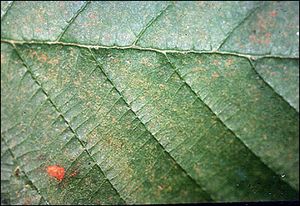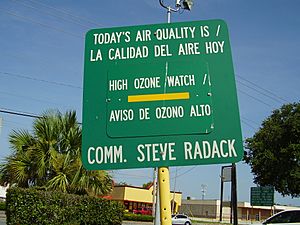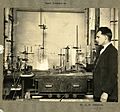Ozone facts for kids
Ozone is a chemical substance with the symbol O3. This means one molecule of ozone is made of three oxygen atoms. Ozone is also called trioxygen. It is a pale blue gas.
Ozone forms naturally from oxygen when ultraviolet light or electrical discharges (like lightning) act on it. It is found in small amounts throughout Earth's atmosphere.
Ozone is very important for planet Earth. There is a part of the stratosphere called the ozone layer that has a lot of ozone. This layer acts like a natural sunscreen, filtering out harmful ultraviolet radiation from the Sun. Without the ozone layer, it would have been very difficult for life to exist on the surface of our planet.
However, ozone can be harmful to animals and plants if there's too much of it. For humans, high levels of ozone can cause irritation in the nose and throat, and even nausea.
Contents
Ozone Air Pollution


Ground-level ozone, also known as tropospheric ozone, is a type of air pollution. It forms near the Earth's surface when sunlight hits certain pollutants. These pollutants, called ozone precursors, mostly come from burning fossil fuels.
While a very small amount of ground-level ozone occurs naturally and is safe, burning fossil fuels increases it to unhealthy levels. High levels of ground-level ozone can harm your lungs and irritate your respiratory system. Being exposed to ozone pollution is linked to serious health problems like asthma, bronchitis, and even heart attacks.
How We Use Ozone
Ozone has many useful applications in industry and for consumers. Because it's a strong oxidizing agent, it's good at breaking down substances and killing tiny organisms.
Industrial Uses
Industries use ozone for many purposes:
- It helps prepare pharmaceuticals (medicines) and other useful organic compounds.
- It can bleach substances and kill germs in air and water.
- Many city drinking water systems use ozone instead of chlorine to kill bacteria. Ozone doesn't leave a taste or smell in the water. It also doesn't form harmful organochlorine compounds.
- In places with plenty of electric power, ozone is a good way to treat water. It's made when needed, so there's no need to transport or store dangerous chemicals.
- Ozone is used to disinfect laundry in hospitals and food factories.
- It can deodorize air and objects, for example, after a fire.
- It kills bacteria on food or on surfaces where food is prepared.
- Industries like breweries and dairy plants use dissolved ozone to clean equipment instead of chemical sanitizers.
- It disinfects cooling towers and helps control bacteria like legionella.
- Ozone sanitizes swimming pools and spas.
- It kills insects in stored grain.
- It cleans yeast and mold spores from the air in food processing plants.
- It washes fresh fruits and vegetables to kill yeast, mold, and bacteria.
- It helps remove contaminants like iron and arsenic from water.
- Ozone helps in making chemical compounds.
- It cleans and bleaches fabrics.
- It helps in processing plastics so inks can stick to them.
- It's used to test how long rubber samples will last.
- It helps get rid of water-borne parasites like Giardia lamblia in water treatment plants.
Many hospitals use large ozone generators to clean operating rooms between surgeries. The rooms are sealed and filled with ozone, which kills or neutralizes any remaining bacteria.
Ozone is also used to bleach wood pulp for making paper. It can help remove the need for chlorine in making high-quality white paper. It can also help detoxify cyanide waste from gold and silver mining.
Consumer Uses
Devices that make high levels of ozone are used to clean and remove odors from empty buildings, rooms, and vehicles.
Some air purifiers sold for homes claim to use low levels of ozone to clean the air. However, the United States Environmental Protection Agency (EPA) says that ozone at safe levels isn't effective at removing many odors or germs like viruses and bacteria. They also warn that some purifiers can produce ozone levels much higher than what is safe.
Ozonated water is used to wash clothes and to sanitize food, drinking water, and surfaces in homes. The U.S. Food and Drug Administration (FDA) allows ozone to be used as an antimicrobial agent on food, including meat and poultry. Studies have shown that ozone dissolved in water can greatly reduce common food-borne bacteria like salmonella. Ozone can also help remove pesticide residues from fruits and vegetables.
In homes and hot tubs, ozone is used to kill bacteria in the water. This helps reduce the amount of chlorine or bromine needed.
Ozone is also widely used in aquariums and fishponds to control bacterial growth, parasites, and diseases. It can also help keep the water clear.
Aquaculture
In aquaculture (raising fish and other aquatic animals), adding ozone to water helps break down organic matter. It also helps reduce harmful nitrite levels by changing them into nitrate.
Images for kids
-
Christian Friedrich Schönbein (1799–1868), who discovered ozone.
-
Ozone can cause cracks in natural rubber tubing.
See also
 In Spanish: Ozono para niños
In Spanish: Ozono para niños








